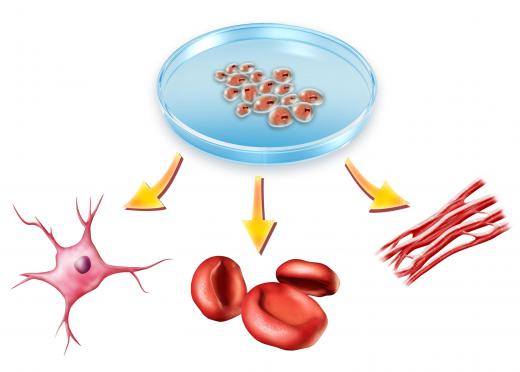What is Anaplasia?
 Niki Foster
Niki Foster
Anaplasia is the abnormal lack of differentiation in cells. It is characteristic of malignant tumors and usually refers to a reversal in cell differentiation. However, it can also refer to the failure of cells to differentiate in the first place.
Many tissues in the human body contain stem cells, which are undifferentiated and can self-renew through cell division. Being undifferentiated means that stem cells are multipotent or multidifferential; they can become one of several cell types depending upon the needs of the body. For example, stem cells in the bone marrow are able to differentiate into all the different types of blood cells.

Anaplasia occurs when differentiated body cells return to an undifferentiated state, often forming a tumor. Cells undergoing anaplasia also often show an increased ability to multiply. Stem cells that fail to differentiate properly can also be the source of cancerous tumors.
Most body cells contain a nucleus, which can be considered the control center of the cell and contains most of the cell's genetic material. Cytoplasm fills the area between the cell membrane, the outer boundary of the cell, and the nucleus. Cells that undergo anaplasia are characterized by large, darkly-colored nuclei and large cytoplasm-to-nucleus ratios, 1:1 instead of the normal 1:4 or 1:6. In addition, anaplasia may result in cells with multiple nuclei, and the cells themselves are often abnormally large.
The nuclei of cells with anaplasia are often abnormally shaped. The nucleolus, a structure inside the cell nucleus that contains ribosomal ribonucleic acid (rRNA) and carries the main responsibility for all cellular functions, is also often abnormally large in an anaplastic cell. Mitosis, or cell division, not only occurs much more often than usual, but is also atypical in nature. While normal mitosis is bipolar, with genetic material duplicating and dividing into two daughter cells, anaplasia may result in tripolar or quadripolar mitosis.
Anaplasia can also cause cells to grow in atypical relation to each other. While normal cells grow into a certain type of tissue matrix depending on their function, anaplastic cells show no such regularity. Anaplasia is the most extreme form of malfunction in cellular growth.
AS FEATURED ON:
AS FEATURED ON:











Discussion Comments
I truly hope that stem cell research continues to progress in the new decade or so. I don't know a lot about it, but it seems like there are so many theories and cures for cancer and other diseases involving cell differentiation that are on the brink of a cure. It would be wonderful if we could truly find a way to "cure" tumors.
@anon37762 - Maybe she has cancer, or will develop it? That is the horrible thing about cancer, it sometimes seems to sneak up on those in perfect health, and out of nowhere. I hope your friend recovers from whatever it turns out to be.
My 65 year old friend is going through a terrible time. Her wbc is low and the doctor told her the bone marrow is not producing. This just happened about two weeks ago. She is not overweight and looks in perfect health. They have done lots of blood work. What can happen?
Post your comments